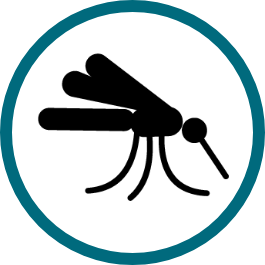Prompt diagnosis and appropriate care for malaria could prevent over 300,000 deaths of children under five each year.1 Fact Sheet: World Malaria Report 2015
World Health Organization
2015 This is an occasional, often seasonal, behavior that needs to be practiced within 24 to 48 hours of the onset of suspected symptoms.

Care for Malaria
Caregivers appropriately manage care for signs and symptoms of malaria for children
Key Points from Global Research
- Quality provider care, accurate diagnosis, treatment and counseling ensure caregivers respond better and return as needed because they feel respected and have confidence in a provider’s ability to help their children.
- Easy and continual access to qualified providers and medicines encourages caregivers to seek care within 24 hours of a fever, instead of waiting until their child’s condition worsens.
- Support from community members assures that caregivers can seek care and fully complete prescribed treatments.
Behavior Profile Sample: Care for Malaria
A Behavior Profile is a summary analysis of each behavior. This sample draws from global evidence and illustrates the result of using the Create Behavior Profiles Tool to analyze factors, supporting actors and strategies and to ensure logical pathways exist between strategies proposed and factors related to the practice of the behavior. This sample may be used as a starting point or reference for creating Behavior Profiles.
| Improve maternal and child survival | |
|
Caregivers appropriately manage care for signs and symptoms of malaria for children Indicator: Among children under age five with fever in the two weeks preceding the survey, percentage for whom advice or treatment was sought from a health facility or provider
|
Behavior Analysis |
Strategy | ||
|---|---|---|---|
STEPSWhat steps are needed to practice this behavior?
Click on any box |
FACTORSWhat factors may prevent or support practice of this behavior? These should be analyzed for each country context.StructuralAccessibility: Caregivers cannot access health facilities because facilities are too far Accessibility: Caregivers cannot receive care because malaria prevention, diagnosis and treatment supplies are unavailable Accessibility: Caregivers do not access formal health facilities because they exhaust all local options first Service Provider Competencies: Caregivers cannot obtain proper diagnosis because providers do not follow National Malaria Case Management guidelines Service Provider Competencies: Caregivers do not seek the care of providers because they may be poorly treated Service Experience: Caregivers do not seek care because health facilities may be poorly equipped and maintained SocialNorms: Caregivers do not seek care because fever is considered normal and is accepted InternalAttitudes and Beliefs: Caregivers do not seek care for fever because they feel treatment is unnecessary or ineffective Knowledge: Caregivers do not seek care because they are unaware that prompt diagnosis and treatment can prevent symptoms and complications of and death from malaria |
SUPPORTING ACTORS AND ACTIONSWho must support the practice of this behavior?InstitutionalProviders: Counsel caregivers on severity of malaria, importance of diagnosis, treatment, danger signs, and when and where to seek care during all interactions Providers: Diagnose malaria using rapid diagnostic tests for all suspected malaria cases Providers: Prescribe anti-malarial per the national surveillance guidelines for all positive RDT results Logistics Personnel: Procure sufficient stock of malaria diagnostics and supplies Managers: Conduct regular supervisory visits to ensure that providers are following approved guidelines and facilities are properly equipped and maintained Managers: Seek innovative ways to provide client-friendly services that are closer to the clients CommunityCommunity Leaders: Support social accountability structures to ensure facilities are properly equipped, maintained, and provide quality services Community and Religious Leaders: Emphasize the severity of malaria, importance of seeking care for fever, and efficacy of diagnosis and treatment options |
POSSIBLE PROGRAM STRATEGIESHow might we focus our efforts based on this analysis?Enabling EnvironmentFinancing: Establish transportation systems and transport within the communities to ensure access to care Policies and Governance: Establish and enforce clear malaria drug policies Systems, Products and ServicesSupply Chain: Set up effective supply chain and quality control systems to public and private sectors to ensure diagnostic tools and treatment for other febrile illnesses are available Quality Improvement: Train providers to adhere to test results and ensure treatment as per national guidelines, and explain protocol to caregivers Quality Improvement: Equip health workers and community health workers with locally tailored behavior-centered job aids Quality Improvement: Emphasize the importance of respectful quality care by providers during pre-service and in service training to ensure clients receive quality treatment Quality Improvement: Develop facilities equipment and maintenance checklist for use by managers and providers to improve health care facilities Demand and UseCommunication: Implement SBCC activities to educate caregivers on malaria symptoms, danger signs, severity, etc. Collective Engagement: Conduct community mobilization activities for caregiver and caregiver support systems around malaria care seeking, diagnosis, treatment and counseling Collective Engagement: Conduct community mobilization activities for caregiver and caregiver support systems around malaria care seeking, diagnosis, treatment and counseling to promote prompt careseeking |
Global Status of Accelerator Behavior
Indicator: Among children under age five with fever in the two weeks preceding the survey, percentage for whom advice or treatment was sought from a health facility or provider
Demographic and Health Survey, Malaria Indicator Survey, The DHS Program Indicator Data API, The Demographic and Health Surveys (DHS) Program


 The Manoff Group was acquired by JSI in 2022.
The Manoff Group was acquired by JSI in 2022.